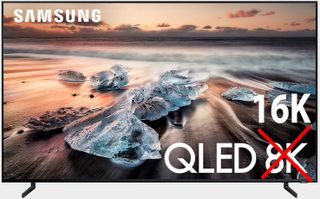DisplayPort 2.0 has enough bandwidth for a 16K resolution display
It's the first major update to DisplayPort since 2016.

A major upgrade to the DisplayPort spec has just been introduced, and it paves the way for higher resolution displays, all the way up to 16K. Just as importantly, if not more so, the new DisplayPort 2.0 standard offers much more bandwidth to deal with faster refresh rates and HDR support on 8K and 4K displays, without resorting to image-degrading image compression.
This has been somewhat of a long time coming. The last time the Video Electronics Standards Association (VESA) announced a major update to the DisplayPort spec was in 2016, with the introduction of DisplayPort 1.4a. Compared to the previous spec, DP 2.0 offers a three-fold increase in bandwidth.
Specifically, DP 2.0 supports a maximum payload of 77.37 gigabits per second (Gbps). The added bandwidth means DisplayPort can for the first time support an 8K resolution (7680x4320) display at 60Hz, with full-color chroma 4:4:4 (no compression), including with 30 bits per pixel (bpp) for HDR10 support.
That's a lot of technobabble. A good primer on image compression and chroma subsampling can be found in this detailed article on Rtings. This comes into play even on some existing 4K monitors. One of those is the Asus ROG Swift PG27UQ, a 4K monitor with a 144Hz refresh rate (overclocked) and both HDR and G-Sync support.
When playing HDR games on that panel at its native 10-bit color depth, you're limited to 98Hz before chroma subsampling comes into play. DisplayPort 1.4a just doesn't offer enough bandwidth to go any higher without resorting to chroma subsampling.
DP 2.0 fattens the pipe considerably, and can support the following setups:
- One 16K (15360x8460) display @ 60Hz and 30 bpp 4:4:4: HDR (with DSC)
- One 10K (10240x4320) display @ 60Hz and 24 bpp 4:4:4 (no compression)
- Two 8K (7680x4320) displays @ 120Hz and 30 bpp 4:4:4: HDR (with DSC)
- Two 4K (3840x2160) displays @ 144Hz and 24 bpp 4:4:4 (no compression)
- Three 10K (10240x4320) displays @ 60Hz and 30 bpp 4:4:4: HDR (with DSC)
- Three 4K (3840x2160) displays @ 90Hz and 30 bpp 4:4:4: HDR (no compression)
Those are all through the native DisplayPort connector. If going through USB-C as enabled by DisplayPort Alt Mode (which allows for simultaneous SuperSpeed USB data and video), the upgraded spec enables the following:
PC Gamer Newsletter
Sign up to get the best content of the week, and great gaming deals, as picked by the editors.
- Three 4K (3840x2160) displays @ 144Hz and 30 bpp 4:4:4 HDR (with DSC)
- Two 4Kx4K (4096x4096) displays (for AR/VR headsets) @ 120Hz and 30 bpp 4:4:4 HDR (with DSC)
- Three QHD (2560x1440) @ 120Hz and 24 bpp 4:4:4 (no compression)
- One 8K (7680x4320) display @ 30Hz and 30 bpp 4:4:4 HDR (no compression)
That's a perhaps more relevant set of specs, since realistically manufacturers are not going to be targeting consumers with 16K or 10K displays in the near future.
Bear in mind that none of this gets into the hardware requirements of actually playing games at 4K and eventually 8K. It takes a meaty GPU to play demanding games at 4K, particularly at higher refresh rates. At least now, however, there is a spec waiting once the hardware catches up.
Paul has been playing PC games and raking his knuckles on computer hardware since the Commodore 64. He does not have any tattoos, but thinks it would be cool to get one that reads LOAD"*",8,1. In his off time, he rides motorcycles and wrestles alligators (only one of those is true).
Most Popular






